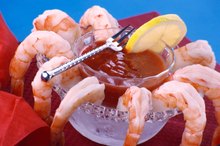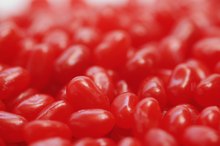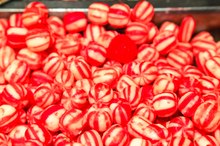Signs & Symptoms of an Allergy to Red Dye
Red food dye is a common food allergy that has been shown to cause reactions in some people who ingest it. While it is commonly referred to as a food allergy, it is actually more of a food intolerance, as it doesn't generally cause a true allergic response in the body, although it can for some. Because of this, red food dye allergy can be difficult to test for and diagnose. Red food dye allergy is becoming increasingly common in children because the dye is featured prominently in candies, fruit snacks, gum and other treats. There are several types of red food dye. Reactions most commonly occur after ingesting red dye No. 40, although they can happen with any red dye. This food intolerance has a very broad range of symptoms, ranging from minor to severe, and can affect multiple body systems.
Gastrointestinal Symptoms
One of the most common reactions to red food dye is gastrointestinal distress. Many people experience symptoms like diarrhea, gas or bloating. Some may experience vomiting shortly after eating an item colored with red food dye. These symptoms normally only last a short time and are rarely life threatening. Symptoms often cease as soon as the dye passes from the system. Continued exposure to red dye, like eating red candies daily throughout the week, can cause these symptoms to repeat themselves and can lead to dehydration and fatigue.
Skin Symptoms
Signs & Symptoms of an Allergy to Red Dye
Learn More
Red dye allergy can present with skin symptoms. After ingesting red dye, people with this sensitivity can develop rashes, skin redness, tingling, itchiness or tightness. Some people will develop hives. Persons who suffer from eczema often note an increase in breakouts or an increase in the itchiness and dryness of existing eczema. Sometimes these reactions are very minor and go away on their own. Some people find relief after taking over-the-counter medicines, like Benadryl, while others need medical intervention to stop their symptoms.
Cold and Flu-Like Symptoms
Red food dye intolerance causes common cold and flu-like symptoms in some people. These symptoms can often be mistaken for colds or seasonal allergies because they cause similar reactions. For example, after ingesting red food dye, a person may experience sneezing, itchy nose, itchy throat, watery eyes or itchy eyes. Sometimes these symptoms can be controlled by over-the-counter or prescription allergy medications and the food allergy can go undiagnosed for years.
Miscellaneous Symptoms
Can Food Allergies Cause Dry Skin and Hair Loss?
Learn More
Each person's body reacts differently to allergies and food intolerance. Often, symptoms you may not normally associate with food can occur. People with red food allergies have reported dizziness, trouble sleeping, poor concentration, loss of appetite, swelling, joint pain and seizures. There's just no way to predict for certain how your body will react to food intolerance. Keeping a food and symptom diary can be helpful to you and your health care provider in diagnosing food allergies and intolerances.
Severe Reactions
Red food dye reactions are generally mild and short-lived, but for some, the reactions are more severe, and even potentially deadly. Anaphylaxis, or severe allergic reaction, can cause the throat to swell closed, blocking the airway. It can lead to shock, as well as organ failure, and if not treated quickly, it can even lead to death. Severe reactions can lead to seizures or coma in rare cases. There are also studies that link food dye to autism and ADHD. If you suspect you may have reactions to red food dye, always discuss your symptoms with your doctor to avoid potential complications.
Related Articles
References
Writer Bio
A Jill-of-all-trades, Lillian Downey is a certified Responsible Sexuality Educator, certified clinical phlebotomist and a certified non-profit administrator. She's also written extensively on gardening and cooking. She also authors blogs on nail art blog and women's self esteem.








